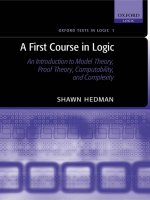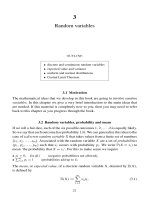Springer introduction to focused ion beams instrumentation theory,techniques and practice giannuzzi 2005 springer
Bạn đang xem bản rút gọn của tài liệu. Xem và tải ngay bản đầy đủ của tài liệu tại đây (19.45 MB, 377 trang )
TeAM
YYeP
G
Digitally signed by
TeAM YYePG
DN: cn=TeAM
YYePG, c=US,
o=TeAM YYePG,
ou=TeAM YYePG,
email=yyepg@msn.
com
Reason: I attest to
the accuracy and
integrity of this
document
Date: 2005.07.01
19:20:13 +08'00'
INTRODUCTION TO FOCUSED ION
BEAMS
Instrumentation, Theory, Techniques and Practice
This page intentionally left blank
INTRODUCTION TO FOCUSED ION
BEAMS
Instrumentation, Theory, Techniques and Practice
Edited by
Lucille A. Giannuzzi
FEI Company
Fred A. Stevie
North Carolina State University
Springer
eBook ISBN:
Print ISBN:
0-387-23313-X
0-387-23116-1
©2005 Springer Science + Business Media, Inc.
Print ©2005 Springer Science + Business Media, Inc.
Boston
All rights reserved
No part of this eBook may be reproduced or transmitted in any form or by any means, electronic,
mechanical, recording, or otherwise, without written consent from the Publisher
Created in the United States of America
Visit Springer's eBookstore at:
and the Springer Global Website Online at:
Dedication
This book is dedicated to Jeff
Bindell, whose insight made it
possible to have leading edge
instrumentation available and
whose inclusiveness fostered the
interactions that provided much
of the material for this work.
This page intentionally left blank
Contents
Dedication
Contributing Authors
Preface
The Editors
Acknowledgments
1. The Focused Ion Beam Instrument
F. A. STEVIE, L. A. GIANNUZZI, AND B. I. PRENITZER
v
xi
xiii
xv
xvii
1
2. Ion - Solid Interactions
L. A. GIANNUZZI, B. I. PRENITZER, B. W. KEMPSHALL
13
3. Focused Ion Beam Gases for Deposition and Enhanced Etch
F. A. STEVIE, D. P. GRIFFIS, AND P. E. RUSSELL
53
4. Three-Dimensional Nanofabrication Using Focused Ion Beams
T. KAITO
73
5. Device Edits and Modifications
K. N. HOOGHAN
87
viii
Introduction to Focused Ion Beams
6. The Uses of Dual Beam FIB in Microelectronic Failure Analysis
B.HOLDFORD
107
7. High Resolution Live Imaging of FIB Milling Processes For Optimum
Accuracy
133
P. GNAUCK, P. HOFFROGGE, M. SCHUMANN
8. FIB For Materials Science Applications - A Review
M. W. PHANEUF
143
9. Practical Aspects of FIB TEM Specimen Preparation
R. ANDERSON AND S. J. KLEPEIS
173
10. FIB Lift-Out Specimen Preparation Techniques
201
L.A. GIANNUZZI, B. W. KEMPSHALL, S.M. SCHWARZ, J.K. LOMNESS,
B.I. PRENITZER, AND F.A. STEVIE
11. A FIB Micro-Sampling Technique And A Site Specific TEM Specimen
229
Preparation Method
T.KAMINO, T.YAGUCHI, T.HASHIMOTO, T.O HNISHI AND K.U MEMURA
12. Dual-Beam (FIB-SEM) Systems
R. J. YOUNG AND M. V. MOORE
247
13. Focused Ion Beam Secondary Ion Mass Spectrometry (FIB-SIMS) 269
F. A. STEVIE
14. Quantitative Three-Dimensional Analysis Using Focused Ion Beam
281
Microscopy
D.N. DUNN, A.J. K UBIS AND R. H ULL
15. Application of FIB In Combination With Auger Electron
Spectroscopy
E. L. PRINCIPE
301
Appendix A: Ga Ion Sputter Yields
329
Appendix B: Backsputtered Ga Ion Fraction
333
Appendix C: 30 keV Ga Ion Range at 0 degrees
337
Appendix D: 30 keV Ga Ion Range at 88 degrees
341
ix
Introduction to Focused Ion Beams
Appendix E: 5 keV Ga Ion Range at 0 degrees
345
Appendix F: 5 keV Ga Ion Range at 88 degrees
349
Notes
353
Index
355
This page intentionally left blank
Contributing Authors
Ron Anderson, Microscopy Today
Derren N. Dunn, IBM
Lucille A. Giannuzzi, FEI Company
Peter Gnauck, Carl Zeiss SMT, Inc.
Dieter P. Griffis, North Carolina State University
T.Hashimoto, Hitachi High-Technologies
Peter Hoffrogge, LEO Elektronenmikroskopie GmbH
Becky Holdford, Texas Instruments, Inc.
Kultaransingh (Bobby) N. Hooghan, Agere Systems
Robert Hull, University of Virginia
Takashi Kaito, Seiko Instruments, Inc.
Takeo Kamino, Hitachi Science Systems
Brian W. Kempshall, NanoSpective Inc.
Stanley J. Klepeis, IBM Microelectronics Division
A.J. Kubis, University of Virginia
Janice K. Lomness, University of Central Florida
Mary V. Moore, FEI Company
T.Ohnishi, Hitachi High-Technologies
Mike W. Phaneuf, Fibics Inc.
Brenda I. Prenitzer, NanoSpective Inc.
Edward Principe, Carl Zeiss SMT, Inc.
Phil E. Russell, North Carolina State University
Fred A. Stevie, North Carolina State University
M.Schumann, Carl Zeiss SMT, Inc.
Stephen M. Schwarz, University of Central Florida, NanoSpective Inc.
K.Umemura, Hitachi Central Laboratory
xii
Introduction to Focused Ion Beams
T.Yaguchi, Hitachi Science Systems
Richard Young, FEI Company
Preface
The focused ion beam (FIB) instrument has experienced an intensive
period of maturation since its inception. Numerous new techniques and
applications have been brought to fruition by the tireless efforts of some very
innovative scientists with the foresight to recognize the potential of this
upstart apparatus. Over the past few years, the FIB has gained acceptance as
more than just an expensive sample preparation tool, and has taken its place
among the suite of other instruments commonly available in analytical and
forensic laboratories, universities, geological, medical and biological
research institutions, manufacturing plants, and more. The applications for
FIB that have yet to be realized are endless. The future for this instrument is
certain to be filled with innovation and excitement.
Although the utility of the FIB is not limited to the preparation of
specimens for subsequent analysis by other analytical techniques, it has
revolutionized the area of TEM specimen preparation. One anecdotal
example is relayed by Lucille Giannuzzi, one of the editors of this book.
Approximately 18 months of Lucille’s graduate research effort was devoted
to the development of a TEM specimen preparation technique for the crosssection analysis of galvanized steel. Upon her introduction to an FEI 611
FIB in 1995, the value of the FIB instrument, which was then capable of
preparing TEM specimens of semiconductor materials in about five hours,
was overwhelmingly and immediately apparent.
Today’s FIB instruments can prepare TEM specimens in less than an
hour. The FIB has also been used to prepare samples for numerous other
analytical techniques, and offers a wide range of other capabilities. While the
mainstream of FIB usage remains within the semiconductor industry, FIB
usage has expanded to applications in metallurgy, ceramics, composites,
xiv
Introduction to Focused Ion Beams
polymers, geology, art, biology, Pharmaceuticals, forensics, and other
disciplines. In addition, the FIB has been used to prepare samples for
numerous other analytical techniques. Computer automated procedures have
been configured for unattended use of FIB and dual platform instruments.
New applications of FIB and dual platform instrumentation are constantly
being developed for materials characterization and nanotechnology. The site
specific nature of the FIB milling and deposition capabilities allows
preparation and processing of materials in ways that are limited only by
one’s imagination. Additional uses and applications will likely have been
discovered by the time that this volume hits the shelves. The hardest task in
editing this compilation was to decide when to stop and send it to press.
In this book we have attempted to produce a reference on FIB geared
towards techniques and applications. The first portion of this book
introduces the basics of FIB instrumentation, milling, and deposition
capabilities. The chapter dedicated to ion-solid interactions is presented so
that the FIB user can understand which parameters will influence FIB
milling behavior. The remainder of the book focuses on how to prepare and
analyze samples using FIB and related tools, and presents specific
applications and techniques of the uses of FIB milling, deposition, and dual
platform techniques. May you have as much fun working with FIB
instruments as we continue to have!!
The Editors
Lucille A. Giannuzzi recently changed positions from Professor,
Mechanical Materials and Aerospace Engineering at the University of
Central Florida, to Field Product Marketing Engineer for FEI Company. Her
research endeavors have broadly focused on structure/property relationships
of materials using FIB/TEM methods, ion-solid interactions, and FIB and
DualBeam applications and development. She has co-taught short courses
on FIB and FIB/TEM specimen preparation at UCF and Lehigh University
and has been a local affiliates and traveling speaker for both the Microscopy
Society of America and the Microbeam Analysis Society. Dr. Giannuzzi is
on the editorial board of Microscopy and Microanalysis, on MAS Council,
on the MSA education committee, and is also a member of ACerS, ASM
International, AVS, MRS, and TMS.
Fred A. Stevie is a Senior Researcher at North Carolina State University.
His career in materials characterization spans more than 30 years with a
range of techniques, principally with SIMS and FIB. His FIB work has
concentrated on the interaction of FIB with other analytical methods,
particularly in sample preparation for TEM analysis and EDS quantification.
He is the AVS instructor for SIMS and co-instructor for FIB, and has cotaught short courses on FIB/TEM specimen preparation. He is on the
advisory board of Surface and Interface Analysis, an Associate Editor of
Surface Science Spectra, a Fellow of AVS, and a member of ASM
International and MAS.
This page intentionally left blank
Acknowledgments
First and foremost, we are indebted to the hard work, dedication, and
patience from the numerous authors who made contributions to this book.
Funding agencies that have contributed to this work over the years are
gratefully acknowledged. In addition, we thank our employers, both past
and present, for allowing us the opportunity to dedicate time and resources
in this area. Last but not least, we also recognize the encouragement and
support of our families.
This page intentionally left blank
Chapter 1
THE FOCUSED ION BEAM INSTRUMENT
F. A. Stevie1, L. A. Giannuzzi2, and B. I. Prenitzer3
1
North Carolina State University, Analytical Instrumentation Facility, Raleigh, NC 27695.
FEI Company, Hillsboro, OR 97124; 3NanoSpective Inc., Orlando, FL 32826.
2
Abstract:
The typical focused ion beam (FIB) instrument consists of a vacuum system,
liquid metal ion source, ion column, stage, detectors, gas inlets, and computer.
The liquid metal ion source provides the finely focused ion beam that makes
possible high lateral resolution removal of material. Five axis motorized
eucentric stage motion allows rapid sputtering at various angles to the
specimen. The ion beam interaction with organo-metallic species facilitates
site specific deposition of metallic or insulating species. Other gases may be
used for enhanced etching of materials. The combination of a scanning
electron microscope column and a FIB column forms a dual platform system
that provides enhanced capabilities.
Key words:
Focused ion beam, FIB, liquid metal ion source, LMIS, Ga
1.
THE BASIC FIB INSTRUMENT
The basic FIB instrument consists of a vacuum system and chamber, a
liquid metal ion source, an ion column, a sample stage, detectors, gas
delivery system, and a computer to run the complete instrument as shown
schematically in Figure 1. The instrument is very similar to a scanning
electron microscope (SEM). FIB instruments may be stand-alone single
beam instruments. Alternatively, FIB columns have been incorporated into
other analytical instruments (either commercially or in research labs) such as
an SEM, Auger electron spectroscopy, transmission electron microscopy, or
secondary ion mass spectrometry, the most common of which is a FIB/SEM
dual platform instrument. The ion column in a single beam FIB instrument
is typically mounted vertically. In contrast, dual platform instruments
2
Chapter 1
usually have the FIB mounted at some angle with respect to vertical (i.e., the
SEM column). Details on combined FIB/SEM applications are discussed
elsewhere in this volume.
What follows below is a basic description of how a FIB instrument
works. The interested reader may visit the references listed for additional
details on ion optics and on the physics of liquid metal ion sources.
Figure 1. (a) A schematic diagram of a basic FIB system. (b) A single beam FEI 200TEM
FIB instrument located at the University of Central Florida.
1. The Basic FIB Instrument
2.
3
THE VACUUM SYSTEM
A vacuum system is required to make use of the ion beam for analysis.
The typical FIB system may have three vacuum pumping regions, one for
the source and ion column, one for the sample and detectors, and a third for
sample exchange. The source and column require a vacuum similar to that
used for field emission SEM sources (i.e., on the order of
torr) to
avoid contamination of the source and to prevent electrical discharges in the
high voltage ion column. The sample chamber vacuum can be at higher
pressure and the system can be used with this chamber in the
torr
range. Pressures in the
torr range will show evidence of interaction of
the ion beam with gas molecules because the mean free path of the ions
decreases as the chamber pressure is increased. The mean free path at high
pressure is reduced to the point where the ions can no longer traverse the
distance to the sample without undergoing collisions with the gas atoms or
molecules. Ion pumps are normally used for the primary column and
turbomolecular pumps backed by oil or dry forepumps are typically used for
the sample and sample exchange chambers.
3.
THE LIQUID METAL ION SOURCE
The capabilities of the FIB for small probe sputtering are made possible
by the liquid metal ion source (LMIS). The LMIS has the ability to provide a
source of ions of ~ 5 nm in diameter. Figure 2a shows a schematic diagram
of a typical LMIS which contains a tungsten needle attached to a reservoir
that holds the metal source material. There are several metallic elements or
alloy sources that can be used in a LMIS. Gallium (Ga) is currently the most
commonly used LMIS for commercial FIB instruments for a number of
reasons: (i) its low melting point
minimizes any reaction or
interdiffusion between the liquid and the tungsten needle substrate, (ii) its
low volatility at the melting point conserves the supply of metal and yields a
long source life, (iii) its low surface free energy promotes viscous behaviour
on the (usually W) substrate, (iv) its low vapor pressure allows Ga to be used
in its pure form instead of in the form of an alloy source and yields a long
lifetime since the liquid will not evaporate, (v) it has excellent mechanical,
electrical, and vacuum properties, and (vi) its emission characteristics enable
high angular intensity with a small energy spread.
4
Chapter 1
Figure 2. (a) A schematic diagram of a liquid metal ion source (LMIS) and (b) an actual
commercial Ga LMIS (courtesy of FEI Company).
1. The Basic FIB Instrument
5
ion emission occurs via a two step process as described below: (i)
The heated Ga flows and wets a W needle having a tip radius of
Once heated, the Ga may remain molten at ambient conditions for weeks due
to its super-cooling properties. An electric field
applied to the
end of the wetted tip causes the liquid Ga to form a point source on the order
of 2-5 nm in diameter in the shape of a “Taylor cone.” The conical shape
forms as a result of the electrostatic and surface tension force balance that is
set up due to the applied electric field. (ii) Once force balance is achieved,
the cone tip is small enough such that the extraction voltage can pull Ga
from the W tip and efficiently ionize it by field evaporation of the metal at
the end of the Taylor cone. The current density of ions that may be extracted
is on the order of
A flow of Ga to the cone continuously
replaces the evaporated ions.
The applied voltage/emission current output characteristics of a LMIS are
non-linear. In FEI instruments, the extraction voltage is typically set to a
constant value and the suppressor voltage is used to generate emission
current from the LMIS. A finite voltage is needed to create the Taylor cone
shape and result in emission current. The emission current will then rise
with applied voltage on the order of
The source is generally
operated at low emission currents
to reduce the energy spread of
the beam and to yield a stable beam. At low emission current, the beam may
consist of singly or doubly charged monomer ions, and neutral atoms which
are not ionized. As the current increase, the propensity for the formation of
dimmers, trimers, charged clusters, and charged droplets increases.
As the source ages, the suppressor voltage is gradually increased to
maintain the beam current necessary for the constant extraction voltage.
When an increase in suppressor voltage will no longer yield a working beam
current (i.e., will no longer start the source), the source must be re-heated.
Sometimes a larger extraction voltage (i.e., an “over voltage”) may be used
to start the source which is then reduced as soon as emission begins. The
reservoir size is quite small and thus, the source can only be heated a limited
number of times. To extend the source lifetime, heating should be performed
only when necessary. The lifetime of a LMIS depends on its inherent
material properties and the amount of material in the reservoir and is
measured in terms of
per mg of source material. Typical source
lifetimes for Ga are
4.
THE ION COLUMN
Once the
ions are extracted from the LMIS, they are accelerated
through a potential down the ion column. Typical FIB accelerating voltages









